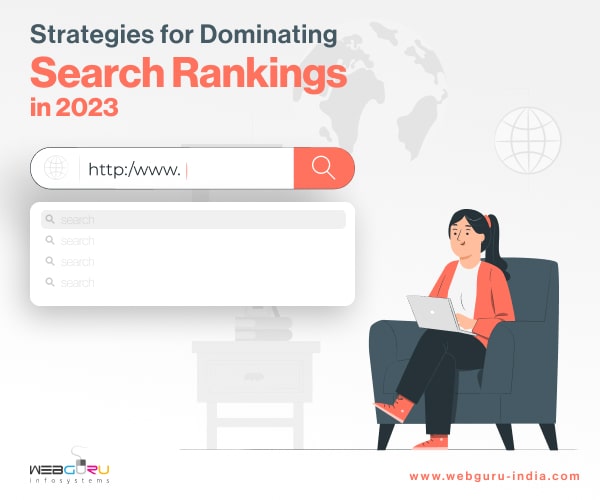Home Blog SEO Services Strategies for Dominating Search Rankings in 2023
Strategies for Dominating Search Rankings in 2023
- 06 Jul / 2023
- 2,017 views
- 7 Min Read

For businesses, search engine rankings have become crucial to drive organic traffic and revenue growth. Securing the top spot on Google can significantly impact your website’s visibility and success. Top SEO agencies worldwide are constantly competing against each other to ensure their clients always retain the top spot.
So, how can you stand out? In this article, we will explore over 15 effective strategies to help you achieve and maintain that coveted #1 ranking on Google in 2023 and beyond.
1. Understanding Google’s Algorithm in 2023
Google’s algorithm is ever-evolving, continuously adapting to provide the best user experience. To succeed in SEO, it’s essential to understand the key elements of the algorithm and how they influence rankings. Here are the critical points to consider:
• Google’s focus on user experience: Google prioritizes websites that offer high-quality user experiences, rewarding them with better rankings.
• Prominent ranking factors: In 2023, certain factors have gained more prominence, such as mobile-friendliness, page speed, user engagement, and content relevance.
• The role of AI and machine learning: Google utilizes artificial intelligence and machine learning to understand user intent, interpret content, and deliver personalized search results.
2. Comprehensive Keyword Research
Keyword research forms the foundation of any successful SEO strategy. By identifying relevant and high-traffic keywords, you can optimize your content to match user search queries. Consider the following tips:
• Targeting relevant keywords: Understand your target audience and their search intent to identify keywords that align with their needs.
• Utilizing keyword research tools: Leverage tools like Google Keyword Planner, SEMrush, or Ahrefs to discover keyword opportunities, search volumes, and competition levels.
• Long-tail keywords: Incorporate long-tail keywords to target specific niches and capture more qualified traffic.
3. High-Quality Content Creation
Content is the backbone of SEO. By creating valuable, well-researched, and engaging content, you can establish your expertise and attract organic traffic. Here’s how to optimize your content:
• User intent and search engine optimization: Align your content with user intent while incorporating relevant keywords to improve visibility in search results.
• E-A-T (Expertise, Authoritativeness, Trustworthiness): Focus on demonstrating expertise, building authority, and establishing trust through high-quality content.
• Format and structure: Use headings, subheadings, bullet points, and paragraphs to make your content scannable and easy to read.
4. Mobile-First Optimization
As mobile usage continues to rise, Google prioritizes mobile-friendly websites in its rankings. To ensure your website is optimized for mobile, consider the following strategies:
• Improve mobile site speed: Optimize images, minify code, and leverage caching techniques to enhance mobile site speed.
• Enhance user experience: Simplify navigation, minimize pop-ups, and ensure that content is easily readable on mobile devices.
• Responsive design: Implement a responsive design that adapts to different screen sizes and resolutions, including foldable screens.
5. Technical SEO Best Practices
Technical SEO focuses on optimizing your website’s technical elements to improve its visibility to search engines. Here are some best practices to consider:
• Website architecture and URL structure: Organize your website into logical categories and use clear, descriptive URLs.
• Optimizing meta tags, headings, and alt attributes: Craft compelling meta titles and descriptions, use appropriate heading tags, and optimize image alt attributes.
• Schema markup: Implement schema markup to provide search engines with structured data and enhance rich snippets in search results.
6. Backlink Building Strategies
Backlinks remain a crucial ranking factor. However, it’s essential to focus on quality rather than quantity. Consider the following strategies for building high-quality backlinks:
• Ethical link-building techniques: Focus on earning backlinks naturally through high-quality content, outreach to relevant websites, and guest blogging.
• Leveraging social media and content promotion: Share your content on social media platforms, industry forums, and online communities to generate backlinks and increase visibility.
7. User Experience and RankBrain
Google’s RankBrain algorithm utilizes artificial intelligence to understand user behavior and deliver relevant search results. Improve user experience to enhance your SEO performance with the following strategies:
• Understanding RankBrain: Familiarize yourself with RankBrain’s role in search rankings and its focus on user experience signals.
• Improve bounce rate and dwell time: Create compelling content that encourages users to stay on your website and engage with your content.
• Enhance overall user satisfaction: Focus on providing a seamless, intuitive, and enjoyable user experience.
8. Local SEO for Geo-Targeted Rankings
If you have a local business, optimizing for local search is essential. Consider the following strategies to improve your local SEO performance:
• Optimize Google My Business: Claim and optimize your Google My Business listing, ensuring accurate and up-to-date information.
• Leverage customer reviews and testimonials: Encourage customers to leave positive reviews and testimonials, which can boost your local search visibility.
• NAP consistency: Ensure consistency in your business name, address, and phone number across all online directories.
9. Voice Search Optimization
With the rise of voice search assistants and devices, optimizing your content for voice queries is crucial. Follow these strategies to improve your voice search visibility:
• Optimize for conversational queries: Focus on long-tail keywords and natural language in your content to match voice search queries.
• Provide direct answers: Structure your content to provide concise, direct answers to commonly asked questions.
• Prepare for voice-based devices: Anticipate the growth of voice-based devices and optimize your website and content accordingly.
10. Video SEO Strategies
Video content continues to gain popularity, making it a valuable asset for SEO. Optimize your videos for better search visibility with these strategies:
• Video titles, descriptions, and tags: Optimize your video metadata with relevant keywords and compelling descriptions.
• Host videos on SEO-friendly platforms: Choose video hosting platforms that offer SEO benefits, such as YouTube or Vimeo.
• Create engaging and shareable videos: Craft high-quality videos that captivate your audience and encourage sharing on social media platforms.
11. Social Signals and SEO
Social media presence can indirectly impact your search rankings. Consider the following strategies to leverage social signals for better SEO performance:
• Building social engagement: Encourage social sharing, likes, comments, and follows to increase social signals associated with your content.
• Influencer partnerships: Collaborate with influencers in your industry to amplify your content’s reach and attract more social engagement.
• Consistent branding: Maintain a cohesive brand presence across social media platforms to establish authority and build trust.
12. Website Performance and Core Web Vitals
Google’s Core Web Vitals are a set of performance metrics that measure user experience. Optimize your website’s performance to align with these metrics:
• Understanding Core Web Vitals: Familiarize yourself with the Core Web Vitals metrics, including page speed, interactivity, and visual stability.
• Strategies for improvement: Optimize your website’s speed by compressing images, minimizing code, and leveraging caching techniques.
• Measure and optimize: Continuously monitor your website’s Core Web Vitals using tools like Google PageSpeed Insights and optimize accordingly.
13. Keeping Up with Algorithm Updates
Google’s algorithm is dynamic and undergoes regular updates. Stay informed and adapt to changes using the following strategies:
• Stay updated on industry news and official announcements: Follow reputable SEO blogs and stay informed about algorithm updates and changes.
• Adaptation strategies: Implement a proactive approach by monitoring your website’s performance, analyzing data, and making necessary adjustments.
• Continuous learning: SEO is an ever-evolving field, so invest in continuous learning to stay ahead of the curve and adapt to future updates.
Conclusion
Achieving the top spot on Google requires a holistic and multifaceted approach. By implementing the 15+ strategies outlined in this article, you can improve your chances of ranking #1 on Google in 2023 and beyond. Remember to focus on user experience, provide valuable content, adapt to evolving algorithms, and regularly monitor and optimize your website’s performance. With dedication and persistence, you can drive organic traffic, enhance your online presence, and achieve long-term business growth through effective search engine optimization.

Priyanka Agarwal
An expert digital marketer with vast knowledge in SEO, SMO, and the like, Priyanka Agarwal writes about the latest trends in digital marketing.
2 comments
Leave a Reply

-
1000+
Happy
Clients -
25+
Countries
Served -
19+
Years of
Trust








Appreciate you sharing, great blog post.Much thanks again. Awesome.
Thanks so much for the blog.Much thanks again. Really Cool.